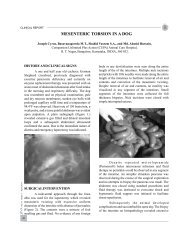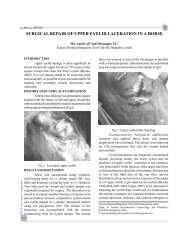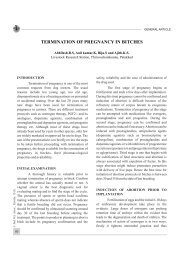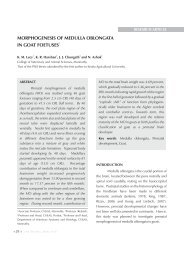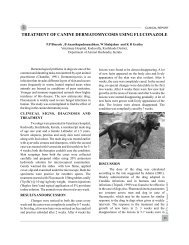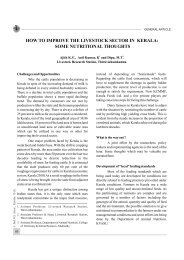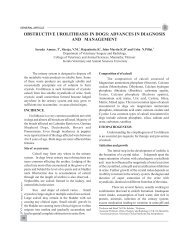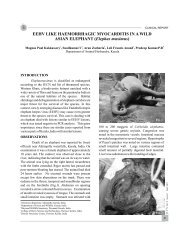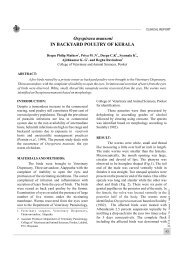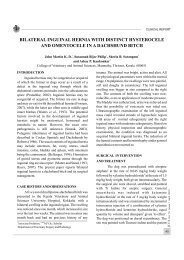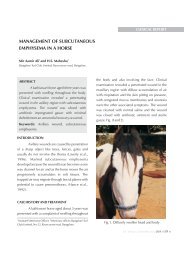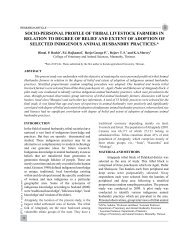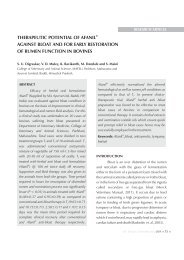morphological studies on the liver of sambar deer - Jivaonline.net
morphological studies on the liver of sambar deer - Jivaonline.net
morphological studies on the liver of sambar deer - Jivaonline.net
Create successful ePaper yourself
Turn your PDF publications into a flip-book with our unique Google optimized e-Paper software.
RESEARCH ARTICLE<br />
it is oblique (Getty 1975).<br />
The right border was short and thick as in<br />
ruminants. This border al<strong>on</strong>g with right lobe and<br />
caudate process presented <strong>the</strong> deep renal impressi<strong>on</strong><br />
for <strong>the</strong> right kidney. The left border was thin and<br />
c<strong>on</strong>vex and it c<strong>on</strong>nected <strong>the</strong> dorsal and ventral<br />
borders. The thin ventral border presented <strong>the</strong> notch<br />
for round ligament which was distinct and deeper as<br />
in hog <strong>deer</strong> (Jayathangaraj et. al., 2000). But in large<br />
ruminants this fissure is indistinct. The round<br />
ligament was present as a slight thickening <strong>of</strong> <strong>the</strong><br />
caudal free edge <strong>of</strong> falciform ligament and it<br />
represented <strong>the</strong> vestige <strong>of</strong> umbilical vein. In small<br />
ruminants it is not evident (Dyce et. al., 1996). The<br />
thick dorsal border lodged <strong>the</strong> caudal vena cava in<br />
<strong>the</strong> sulcus venae cavae. Medial to <strong>the</strong> sulcus venae<br />
cavae, <strong>the</strong> oesophagial notch was noticed at about<br />
<strong>the</strong> middle <strong>of</strong> this border unlike in ruminants where it<br />
is located more medially and to <strong>the</strong> left.<br />
Fig.1. Parietal surface <strong>of</strong> <strong>the</strong> <strong>liver</strong> <strong>of</strong> Sambar <strong>deer</strong><br />
L- Left lobe, R- Right lobe, Q- Quadrate lobe, Cp- Caudate process,<br />
F- Falciform ligament, Rl- Round ligament, Cl- Cor<strong>on</strong>ary ligament,<br />
Rt- Right triangular ligament.<br />
this surface presented a l<strong>on</strong>g triangular area without<br />
serosal covering, area nuda which was closely attached<br />
to <strong>the</strong> diaphragm as in o<strong>the</strong>r ruminants (Getty 1975).<br />
This area was bounded by <strong>the</strong> two divisi<strong>on</strong>s <strong>of</strong> cor<strong>on</strong>ary<br />
ligament. The right triangular ligament c<strong>on</strong>nected <strong>the</strong><br />
caudolateral angle <strong>of</strong> <strong>the</strong> <strong>liver</strong> to <strong>the</strong> dorsolateral<br />
abdominal wall. The left triangular ligament was<br />
noticed near <strong>the</strong> oesophageal notch and it c<strong>on</strong>nected <strong>the</strong><br />
<strong>liver</strong> to diaphragm. These two ligaments were<br />
c<strong>on</strong>nected by <strong>the</strong> narrow cor<strong>on</strong>ary ligament located <strong>on</strong><br />
<strong>the</strong> diaphragmatic surface lateral to <strong>the</strong> caudal vena<br />
cava. The hapato renal ligament was located medial to<br />
<strong>the</strong> right lateral ligament and c<strong>on</strong>nected <strong>the</strong> <strong>liver</strong> to <strong>the</strong><br />
anterior end <strong>of</strong> right kidney.<br />
The caudal visceral surface presented <strong>the</strong><br />
hepatic porta at about its middle (Fig.2). The hepatic<br />
porta presented <strong>the</strong> hepatic artery, portal vein, hepatic<br />
duct and several hepatic lymph nodes. The right and left<br />
hepatic ducts joined to form <strong>the</strong> comm<strong>on</strong> hepatic duct<br />
which opened in <strong>the</strong> duodenum. The line <strong>of</strong> attachment<br />
<strong>of</strong> lesser omentum extended from oesophagial notch to<br />
porta and was almost straight unlike in ruminants where<br />
Fig.2. Visceral surface <strong>of</strong> <strong>the</strong> <strong>liver</strong> <strong>of</strong> Sambar <strong>deer</strong> L- Left<br />
lobe, Q- Quadrate lobe, Pp- Papillary process, Cp- Caudate<br />
process, Hp- Hepatic porta, O- Oesophageal notch, Nr- Notch<br />
for round ligament, Lo- Lesser omentum, V- Vena cava.<br />
In <strong>deer</strong>, <strong>the</strong> lobati<strong>on</strong> <strong>of</strong> <strong>liver</strong> was more<br />
distinct as in small ruminants (Getty, 1975) and<br />
unlike in large ruminants (Fig.2). The left lobe <strong>of</strong> <strong>the</strong><br />
<strong>liver</strong> was located ventral to an imaginary line<br />
c<strong>on</strong>necting <strong>the</strong> oesophagealnotch and <strong>the</strong> notch for<br />
<strong>the</strong> round ligament. This lobe was undivided as in<br />
small and large ruminants, but it showed an arc like<br />
fissure at about <strong>the</strong> middle <strong>of</strong> its visceral surface.<br />
Ano<strong>the</strong>r 'L' shaped fissure was present <strong>on</strong> this lobe<br />
near <strong>the</strong> left border. Two sec<strong>on</strong>dary notches could<br />
also be noticed near <strong>the</strong> notch for <strong>the</strong> round<br />
JIVA Vol. 9 Issue 1 April 2011<br />
29




